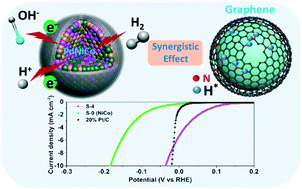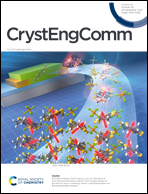MOF-derived PdNiCo alloys encapsulated in nitrogen-doped graphene for robust hydrogen evolution reactions†
Abstract
The hydrogen evolution reaction (HER) is an important step for electrochemical water splitting to produce hydrogen. Functional materials with low cost and robust performance might meet the urgent need for replacement of Pt-based electrocatalysts for the HER. Herein, a simple one-pot method is designed to prepare metal–organic framework (MOF)-derived PdNiCo alloys encapsulated in a nitrogen-doped graphene shell for efficient hydrogen evolution reactions. The electrocatalyst demonstrated an outstanding performance with only 42 mV overpotential to achieve 10 mA cm−2 current density, quite close to that of the commercial 20% Pt/C catalyst. Moreover, the underlying reason for the outstanding performance is that introduction of trace palladium atoms into the core can improve the efficiency of electron transfer from the alloy core to the graphene shell, and the PdNiCo alloy/nitrogen-doped carbon interfaces weaken the hydrogen adsorption energy on the catalyst and thus optimize the Gibbs free energy of the intermediate state (ΔGH*), leading to a remarkable electrocatalytic activity. These results indicate that robust and super stable alloys encapsulated in nitrogen-doped graphene containing a very small amount of noble metal could effectively improve the electrocatalytic performance. This work gives new insights into the investigation of efficient and practical multilayer core–shell structured HER catalysts.



 Please wait while we load your content...
Please wait while we load your content...